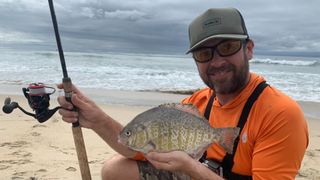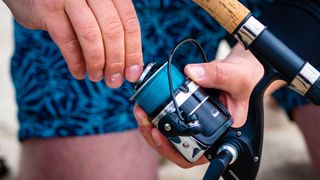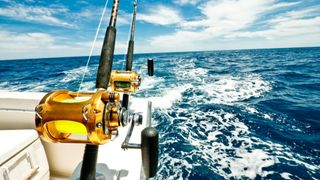How to choose a fishing reel: an expert guide to selecting an essential piece of kit
It's the most important part of your tackle armory, so avoid the most common buyer’s pitfalls as we explain how to choose a fishing reel

Having the right fishing reel for the job can make or break your session as it forms the backbone of your set-up, whatever you’re fishing for. But knowing how to choose a fishing reel can be a minefield for the newcomer with many, many different types available – all designed for a specific task.
However, this purpose is often buried behind a ream or two of techno-waffle and smart acronyms, so we’re going to cut to the chase and tell you really what to look for when picking the best fishing reel.
By the end of this guide, you’ll know how to choose a fishing reel to suit your style of angling, wherever you fish and whatever your target species.
Spinning reels vs conventional reels vs baitcaster reels

The first big subject to understand is that there are three main types of fishing reel to choose from when we’re tackling the main saltwater and freshwater species; spinning reels, conventional reels and baitcaster models. Let’s run through each one and what they’re suitable for as choosing the category of reel to look at is the first task when equipping yourself with a new model.
Spinning reels
A spinning reel is by far the most common reel in use and consists of a stationary spool with line wound onto the spool by a rotating wire arm via a turn of the handle. The reel sits under the rod and most have handles that can be easily changed from left to right-hand wind operation, which is a factor to consider if you favor winding with your left hand as most other reel types come with right-hand-wind as standard.
They’re generally simple, reliable and easy to cast by folding the metal wire arm (called a bale arm) over to allow fishing line out and back to wind line in. They’re also a doddle to maintain or detangle and can be purchased for anything from $10 to $1,000-plus. Generally, spinning reels are useful for any sort of light to heavy fishing with the exclusion of targeting saltwater big fish such as game species or freshwater giants like alligator gar, huge catfish or sturgeon, for example.
If you’re a beginner fishing in almost any type of freshwater or light saltwater environment, a spinning reel is a great place to start due to their ease of use and wide price range. Most shop-sold combos (a rod and reel together) consist of a spinning reel and rod.
Advnture Newsletter
All the latest inspiration, tips and guides to help you plan your next Advnture!
Conventional reels
Conventional reels sit above the rod and operate as a cylindrical spool that winds line back onto the spool when the handle is cranked. A button or lever activates freespool to let line out and most come with a built-in clicker that helps alert the angler to a bite when the fish takes line.
Within the conventional reel realm there are two main types: those that can be cast and are suitable for launching baits off a beach or shoreline with the right rod; and those that aren’t set up to cast and are suited to dropping straight over the side of the boat, pier or jetty – or trolling, for example.
Conventional reels tend to be a little more expensive and complex but are useful in some situations, especially when targeting seriously big fish – bluefin tuna or large sharks, for example. This is when a big two-speed conventional reel holding over a thousand yards of braided main line is necessary and a spinning reel would be useless.
A conventional reel is the best choice for anyone targeting medium to large fish in saltwater, especially when you’re dropping baits or lures straight over the side of the boat or jetty. For an angler with a bit of experience or someone willing to practise, a casting-orientated model is also a great way of targeting larger fish from the shoreline or beach – striped bass, for example.
Baitcasting reels

A baitcasting reel is similar to a conventional reel in that it sits above the rod and retrieves line in the same way, but it has a lower profile and is generally more suited to light freshwater applications, such as lure fishing for bass. They’re a little harder to cast compared to a spinning reel and are more likely to tangle, but they’re light and, in the hands of someone with a bit of experience, effective and satisfying to use.
A spincasting reel is a hybrid between a baitcaster and spinning reel but they’re unnecessary and offer little advantage, so we’ll ignore those. They’re sometimes used by beginners but this is more because they’re often sold in cheap kits, rather than being a good choice.
Note that usually the different types of reel require unique rods for each due to the specialist fitments and set-ups needed, so if you’re matching a reel to an existing rod, check what sort of reel it’s designed for first. Often they’ll be designated Spinning for use with spinning reels, or Conventional for use with conventional and baitcasting reels. Specific baitcasting rods are also sold with special grips to aid grip and casting.
Saltwater vs freshwater
This is an important point to consider when choosing the best reel for the job and a good rule to remember is that all saltwater reels will be fine for use in freshwater, but not all freshwater reels will survive saltwater use.
The main differences between a reel made for saltwater or freshwater use, are usually the corrosion-resistant materials utilised and extra attention paid to sealing the reel as much as possible against saltwater intrusion into the mechanisms of the reel. Without these features, a reel will quickly rust and become useless after saltwater use, making you wish you’d spent a bit extra on getting a saltwater-suitable model in the first place.
Obviously, with lots of moving parts, totally sealing a real against saltwater corrosion is hard but some more expensive high-end reels available utilise clever magnetic oil systems and high-tech bearings to solve the problem. This often makes saltwater-specialist reels more expensive but more durable compared to their freshwater counterparts.
Properly washing a reel in warm freshwater with a mild detergent and use of a corrosion-resisting lubricant spray like Corrosion X will prolong the life of any reel. Freshwater anglers would do well to wash their reels regularly in clean water and use a suitable lubricant and oil to maximise their smooth operation, too.
Fishing reel size numbers explained
Sizing of fishing reels suffers from having little universal measurement system that the manufacturers agree on, but there are a few general rules that most can be seen to adhere to. Let’s clear that up as much as possible.
Most reels have a number in the name, usually in the thousands, hundreds or tens; 3000, 300 or 30, for example. The first part of the number is the bit to pay attention to as that usually indicates the size of the reel in terms of its spool capacity and frame dimensions.
For the purposes of clarity we’ll refer to reel sizes using the 1000, 2000 etc scale to give you a better idea of the actual size, as sometimes this designation isn’t clear on the given model name – it might just have a 3 in the name somewhere.
Fishing reel sizes: 500 to 3000
The very smallest spinning reels usually start at 500 size, which is suitable for ultra-light angling such as ice fishing or micro fishing. This will fit in the palm of your hand with room to spare.
Jump to 1000, 2000 and 3000-labeled models (often called 10 / 100, 20 / 200, 30 / 300 etc), and we’re in the territory of useful light spinning reels for species such as trout, crappie, bluegill, bass and catfish, plus very light inshore or surf fishing.
A 3000-size is a great all-round light reel for any angler targeting fish to 20lb on lures or small baits. This size generally offers enough line capacity to cast and land decent fish in most situations without the weight of a larger-spooled reel that might be heavy for a youngster or beginner, or over-balanced on a light rod. It’s a nice starting point for many.
Fishing reel sizes: 4000 to 6000
Up to 4000, 5000 and 6000 sizes, and in spinning reel terms these are a step up in terms of their ability to handle bigger fish and more line. Big catfish, carp, pike, muskie, small to medium-size offshore species and heavier surf fishing are ideal tasks for reels of this size, especially pricier models with heavy duty internal mechanisms and metal bodies. This is the go-to range for a lot of serious fisherfolk with a 4000-6000 size model equipped with a decent drag being a very capable big fish reel.
Fishing reel sizes: 8000, 10,000 and above
Into the 8000-plus sizes and these are specialist tools for handling big fish in saltwater of the largest of freshwater species. The average 8000-size reel will be able to hold many hundreds of yards of 40-100lb braided main line and offers serious stopping power with drag pressures above 30lb on tap against the run of a medium-size shark or big ray.
Many reel manufacturers now offer a 10,000 size or bigger and these are usually equipped with an even meatier drag to stop large sharks and rays with line capacity approaching 750 yards of 40-80lb braided main line.
Fishing reel sizes: conventional reels
Sizing for some conventional and baitcasting reels sometimes follows a similar format but varies hugely company to company, with the notable exception being for large conventional reels where 20, 30, 50, 80 and 130 represent the range of big game reels from small jigging models, 20, and medium-capacity 30s and 50s, to boat winch-level giants in the 130 bracket. Comparing overall reel weights and line capacity between models often offers a truer view of where it sits in the size range.
What to look out for when choosing a fishing reel

Fishing reel marketing is a minefield of technical claims and baffling terminology, so let’s break down the things that make a good fishing reel in real world terms.
Generally, the more bearings the better, as they offer a smoother operation and bracing in useful parts of the reel when targeting larger fish. Cheaper reels with fewer or cheaper bearings will, generally, feel less smooth. Keep them well lubricated and free of salt and grit by regular washing and good care.
What to look out for when choosing a fishing reel: drag mechanism
The drag refers to the mechanism by which the reel gives line under pressure and is operated in most cases by a dial on the front or rear of the spinning reel, or a lever or star-shaped dial on a conventional reel. Having a smooth and reliable drag is vital because a running fish has to be able to take line from the reel without it locking up (and possibly breaking the line).
When targeting larger fish, a reel that’s able to offer substantial drag pressure without locking up or sustaining heat damage from the friction will tire the fish faster than one that can’t offer the same resistance.
When you hear of someone getting “spooled”, this is often because the reel can’t put enough pressure on to stop a running fish and they simply run out of line before they can stop it. Having a reel with a drag matched to the size of the fish you’re targeting is important, as well as setting it correctly to give line before anything breaks.
Drag pressure is measured in pounds; imagine a big weight pulling line directly from the reel spool – the size of the weight needed to engage the drag and start giving line is the drag pressure reading.
A lot of spinning reels offer just a few pounds of drag resistance but this is enough to land most freshwater fish, and a reel offering 20-40lb of drag pressure will be able to handle some big saltwater species, too. Some large conventional reels can handle over 100lb of drag pressure to deal with larger sharks and tuna, but these are highly specialized pieces of equipment costing over $1,000.
Other features to look out for when choosing a fishing reel
Other features to look for include the weight of the reel - is it going to feel weighty on a lightweight rod, for example. And the material the body is made from matters too as that also impacts the weight and durability. Graphite, aluminium and plastic-type materials occupy the cheaper end of the market – composites, magnesium and high-tech alloys the upper end. With most big brands, the price you’ll pay reflects the quality and durability of the materials in use.
Line capacity is also a consideration if you’re engaging in fishing that involves a long cast or big fish but, with most people casting less than 50 yards, that 3000 to 4000-size spinning reel holding 200-300 yards of line is going to be just fine. However, if you’re fishing an offshore wreck in 600ft of water, that’s not going to be much use and a large conventional reel holding double that depth in line is the wiser choice.
Now you know how to choose a fishing reel!
Now you understand the main types of fishing reel available, what they’re useful for, what size works best for you and the other features to look out for, you’ll have a pretty good idea about what reel is going to be top of your shopping list. With so many options available, you’re bound to find a reel that fits your specifications perfectly and at the right price.
An obsessed fisherman since childhood, Ben’s career in fishing has taken him from working as a magazine writer and editor to running his own guiding business in California, where he targets salt and freshwater fish. Ben has decades of experience in selecting the right tackle and honing the best tactics to target all sorts of species, from surf sharks to freshwater catfish, and loves sharing this knowledge. His favorite fishing moments usually involve helping clients catch the fish of a lifetime – and not getting eaten by great white sharks while out on his kayak.
Most Popular

